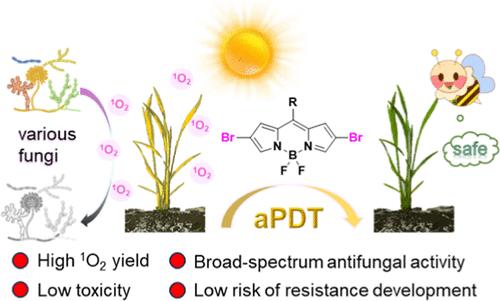探索2,6-二溴体dipys作为植物病原真菌光动力失活的潜在光敏剂
IF 6.2
1区 农林科学
Q1 AGRICULTURE, MULTIDISCIPLINARY
引用次数: 0
摘要
抗菌光动力疗法(aPDT)是克服真菌耐药性的一种有前途的替代策略。它是基于在适当的光敏剂(PS)与充足的自然阳光照射下产生活性氧(ROS)。目前,aPDT在植物病害防治中的进一步应用受到了合适的ps资源有限的制约。本文设计并合成了一组2,6-二溴bodipys,并研究了它们作为aPDT抗8种高破坏性植物病原真菌的新型ps的性能。这些目标化合物通过进入真菌菌丝细胞内部,并在原位产生ROS破坏亚细胞器,显示出优异的广谱抗真菌光动力活性。其中化合物17a单线态氧(o2)生成效率最高,对5种常见植物病原菌的EC50值均较好,分别对葡萄枯萎菌、菌核菌、枯核菌、谷物枯萎菌和绿色木霉的EC50值分别为0.955、0.883、0.281、1.09和1.05 mg/L。这些值与商用PS玫瑰(RB)和杀菌剂硫氟唑胺所达到的值相当,甚至略好。在50 mg/L的浓度下,能抑制水稻离体叶片上茄蚜的生长,并具有有效的防治作用。此外,化合物17a还具有良好的植物亲和性和对蜜蜂等非靶向生物的低毒性。这些结果表明,2,6-二溴化体dipys可能作为潜在的ps用于植物病原真菌的光动力杀伤。本文章由计算机程序翻译,如有差异,请以英文原文为准。

Exploring 2,6-DibromoBODIPYs as Potential Photosensitizers for Photodynamic Inactivation of Phytopathogenic Fungi
Antimicrobial photodynamic therapy (aPDT) is a promising alternative strategy to overcoming fungal resistance. It is based on the generation of reactive oxygen species (ROS) upon irradiation of a suitable photosensitizer (PS) with abundant natural sunlight. Currently, further application of aPDT in controlling plant diseases has been hampered by the limited access to suitable PSs. In this work, we designed and synthesized a set of 2,6-dibromoBODIPYs and investigated their performance as novel PSs for aPDT against eight highly destructive plant pathogenic fungi. Most of these target compounds showed excellent and broad-spectrum antifungal photodynamic activities, as demonstrated in the bioassay results, by entering into the interior of fungal hyphal cells and in situ generating ROS to destroy subcellular organelles. Among those, compound 17a exhibits the highest singlet oxygen (1O2) generation efficiency, with an excellent EC50 value against each of the five common plant pathogens (0.955, 0.883, 0.281, 1.09, and 1.05 mg/L for Valsa mali, Sclerotinia sclerotiorum, Rhizoctonia solani, Fusarium graminearum, and Trichoderma viride, respectively). These values are comparable to or even slightly better than those achieved with the commercial PS Rose Bengal (RB) and the fungicide thifluzamide. It is capable of inhibiting the growth of R. solani on the detached leaves of rice and provides effective protection and curative activities at 50 mg/L. In addition, compound 17a also features excellent plant compatibility and low toxicity to nontargeted organisms including Apis mellifera L. These results indicate that 2,6-dibromoBODIPYs may be used as potential PSs for the photodynamic killing of phytopathogenic fungi.
求助全文
通过发布文献求助,成功后即可免费获取论文全文。
去求助
来源期刊
CiteScore
9.90
自引率
8.20%
发文量
1375
审稿时长
2.3 months
期刊介绍:
The Journal of Agricultural and Food Chemistry publishes high-quality, cutting edge original research representing complete studies and research advances dealing with the chemistry and biochemistry of agriculture and food. The Journal also encourages papers with chemistry and/or biochemistry as a major component combined with biological/sensory/nutritional/toxicological evaluation related to agriculture and/or food.

 求助内容:
求助内容: 应助结果提醒方式:
应助结果提醒方式:


